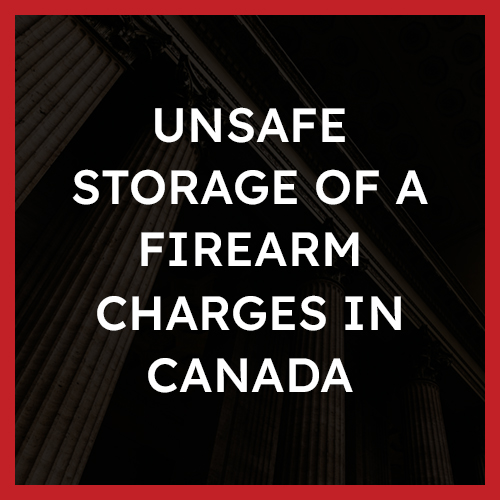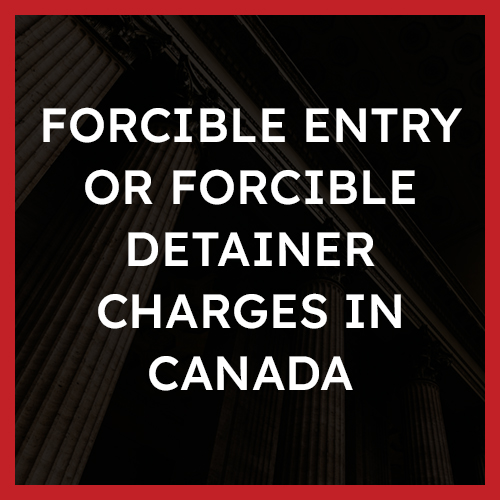Unsafe Storage of a Firearm (s. 86) Charges in Canada: Offences, Defences, Punishments
What is “unsafe storage of a firearm” in Canada?
 Unsafe storage of a firearm is criminalized under section 86 of the Criminal Code alongside other offences related to carrying, handling, shipping, and/or transporting a firearm. Essentially section 86 dictates that all such acts related to a firearm (storing, carrying, handling, etc.) must be exercised with care and with regard for public safety, otherwise one can be subject to criminal liability.
Unsafe storage of a firearm is criminalized under section 86 of the Criminal Code alongside other offences related to carrying, handling, shipping, and/or transporting a firearm. Essentially section 86 dictates that all such acts related to a firearm (storing, carrying, handling, etc.) must be exercised with care and with regard for public safety, otherwise one can be subject to criminal liability.
Unsafe storage of a firearm is a hybrid offence. This means that the Crown can elect to proceed via indictment (more serious category of criminal offences) or summarily (less serious category of criminal offences). The Crown’s election will depend on the circumstances and seriousness of the case. The maximum penalty for a section 86 offence is 2 years imprisonment for a first-time offence or maximum 5 years for any subsequent offence. There is no minimum penalty for unsafe storage of a firearm. There are many different acts or combinations of acts which could ultimately constitute a section 86 offence. See some examples below:
Examples
While this isn’t an exhaustive list, some examples of unsafe storage of a firearm could include:
- You leave a firearm, knife or another weapon as classified in section 86 on an accessible surface such as a car seat, glovebox, kitchen countertop, on a bed, etc.
- You’re waving a firearm around to display that it’s on your person even if you don’t intend on firing it
- You store your firearms loaded
- You transport your firearms loaded
- You fail to use a locking device on certain firearms when storing them
Defences
A strong defence to a charge of unsafe storage of a firearm will depend on the circumstances of one’s case.
However, some common defences against a charge of unsafe storage of a firearm include:
- Lack of mens rea
- Control or possession
- There was a manufacturer defect
- The firearm is not covered by section 86
- Lawful excuse
- Applicable Charter defences
Punishment
The punishment for a section 86 charge (unsafe storage of a firearm) can depend on two main factors:
- The Crowns election (indictable offence vs summary offence); and
- if an indictable election, whether this is a first-time offence or subsequent offence
If the Crown opts to proceed via indictment, the maximum penalty for a section 86 charge is:
- in the case of a first offence, for a term not exceeding two years [imprisonment], and
- in the case of a second or subsequent offence, for a term not exceeding five years [imprisonment].
If charged summarily, the maximum punishment is 2 years less a day imprisonment and/or a $5000 fine. There is no minimum penalty for a section 86 offence meaning imprisonment is not a mandatory sentence.
Overview of the Offence
Section 86 of the Criminal Code reads:
Careless use of firearm, etc.
86 (1) Every person commits an offence who, without lawful excuse, uses, carries, handles, ships, transports or stores a firearm, a prohibited weapon, a restricted weapon, a prohibited device or any ammunition or prohibited ammunition in a careless manner or without reasonable precautions for the safety of other persons.
Contravention of storage regulations, etc.
(2) Every person commits an offence who contravenes a regulation made under paragraph 117(h) of the Firearms Act respecting the storage, handling, transportation, shipping, display, advertising and mail-order sales of firearms and restricted weapons.
Punishment
(3) Every person who commits an offence under subsection (1) or (2)
(a) is guilty of an indictable offence and liable to imprisonment
(i) in the case of a first offence, for a term not exceeding two years, and
(ii) in the case of a second or subsequent offence, for a term not exceeding five years; or
(b) is guilty of an offence punishable on summary conviction.
To secure a conviction, the Crown must show that both the actus reus (guilty act) and mens rea (guilty mind) elements are present. These are discussed in more detail below.
The Guilty Act (Actus Reus)
Because section 86 covers an array of acts, the actus reus or guilty act can capture several acts.
There are three main components to showing the actus reus for this kind of offence:
- The Crown shows that the accused used, carried, handled, shipped, transported or stored one of the weapons listed in section 86;
- the Crown shows that the weapon(s) were/was “a firearm, a prohibited weapon, a restricted weapon, a prohibited device or any ammunition or prohibited ammunition”; and
- the Crown shows that the accused did so “in a careless manner or without reasonable precautions for the safety of other persons”.
The Crown must show all three of these criteria to meet the actus reus standard of the offence. It is not sufficient to show just one or even the majority of them.
Section 86 of the Criminal Code captures all types of firearms including prohibited weapons, restricted weapons, and prohibited devices or ammunition. Definitions for these types of firearms, ancillary weapons and firearm accessories can be found in different places. Most of the definitions can be found in section 84 of the Criminal Code.
prohibited ammunition means ammunition, or a projectile of any kind, that is prescribed to be prohibited ammunition; (munitions prohibées)
prohibited device means
(a) any component or part of a weapon, or any accessory for use with a weapon, that is prescribed to be a prohibited device,
(b) a handgun barrel that is equal to or less than 105 mm in length, but does not include any such handgun barrel that is prescribed, where the handgun barrel is for use in international sporting competitions governed by the rules of the International Shooting Union,
(c) a device or contrivance designed or intended to muffle or stop the sound or report of a firearm,
(d) a cartridge magazine that is prescribed to be a prohibited device, or
(e) a replica firearm; (dispositif prohibé)
prohibited firearm means
(a) a handgun that
(i) has a barrel equal to or less than 105 mm in length, or
(ii) is designed or adapted to discharge a 25 or 32 calibre cartridge,
but does not include any such handgun that is prescribed, where the handgun is for use in international sporting competitions governed by the rules of the International Shooting Union,
(b) a firearm that is adapted from a rifle or shotgun, whether by sawing, cutting or any other alteration, and that, as so adapted,
(i) is less than 660 mm in length, or
(ii) is 660 mm or greater in length and has a barrel less than 457 mm in length,
(c) an automatic firearm, whether or not it has been altered to discharge only one projectile with one pressure of the trigger, or
(d) any firearm that is prescribed to be a prohibited firearm; (arme à feu prohibée)
prohibited weapon means
(a) a knife that has a blade that opens automatically by gravity or centrifugal force or by hand pressure applied to a button, spring or other device in or attached to the handle of the knife, or
(b) any weapon, other than a firearm, that is prescribed to be a prohibited weapon; (arme prohibée)
If you’re uncertain about what category of firearm you carry or the type of weapon you own/control, feel free to visit the Royal Canadian Mounted Police’s website for more information. Furthermore, for laws regarding the safe storage of these different categories of firearms/restricted weapons, see the Firearms Act here.
Carrying, storing, handling, shipping, transporting etc. have all earned different interpretations by the courts as well. For example, the court in a case known as R v Patrick, 2007 CanLII 7579 (ONSC), noted that “carrying does not require personal possession”. For example, having a gun in the glove box of a car can constitute “carrying”.
In R v Carlos, 2001 YKCA 6 (CanLII), the court determined that
A firearm has been ‘stored’ when it has been put aside and the accused is not making any immediate or present use of it. There is no need to establish that the firearm has been put aside for a ‘lengthy period.’ Such a requirement is ambiguous, and does not provide any guidance as to when ‘use’ has ended and ‘storage’ has begun.” It may be “stored” even if the accused places them temporarily out of sight with the intention of retrieving them later…
To meet the third criterion (the accused acted “in a careless manner or without reasonable precautions for the safety of other persons”), the Crown must show that the accused acted in a way which caused a risk to people or property (see: R v Batty, 2014 ONCA 620 (CanLII)).
Examples of acts which have, in the past, met the actus reus standard for a section 86 offence include:
- Storing a firearm in a glovebox (see: R v Patrick, 2007 CanLII 7579 (ONSC))
- Storing a firearm in a dresser (see: R v McDonald, 2016 BCSC 1648 (CanLII))
- Storing a firearm by a furnace (see: R v Roussel, 2014 ABQB 202 (CanLII))
The Guilty Mind (Mens Rea)
The mens rea or the guilty mind speaks to the accused’s degree of intent during the argued commission of the offence. In criminal law there are different standards of mental intent. For a section 86 offence, the standard is objective. This means that the court asks whether the accused, in the commission of the offence, had the standard of care of a reasonable person. This is sometimes referred to as the reasonable person test.
For a section 86 analysis, the court only needs to ask whether the accused knew of the circumstances of the careless use, handling or storage. The prosecution does not need to go further and prove that he or she appreciated the risks. (see: R v Finlay, 1993 CanLII 63 (SCC), [1993] SCR 103). We might also ask: were the accused’s actions a marked departure from the standard of care of a reasonably prudent person? (see: Optimum Insurance Co Inc v Donovan, 2009 NBCA 6 (CanLII)). “The court must also be satisfied beyond a reasonable doubt that there were not enough ‘precautions taken by the accused to avoid the creation of risk’ and the accused had the ‘capacity …to meet the standard of care of a reasonably prudent person in the circumstances’ but failed to do so”. Furthermore, “the standard of care is assessed objectively while taking into account the accused’s capacities in the circumstances and the “accused’s ability to control or compensate for his … incapacities” (see: R v Finlay, 1993 CanLII 63 (SCC), [1993] SCR 103).
The reasonable person test has been grappled with in numerous Canadian cases. Some essentials of the ‘test’ include that the reasonable person is:
- “reasonable, informed, practical and realistic” who “consider the matter in some detail” (see: R v S (R.D.), 1997 CanLII 324 (SCC), [1997] 3 SCR 484).
- not a “very sensitive or scrupulous” person, but is “right-minded” (see: R v S (R.D.), 1997 CanLII 324 (SCC), [1997] 3 SCR 484)
- dispassionate and fully apprised of the case (see: R v Collins, 1987 CanLII 84 (SCC), [1987] 1 SCR 265; and R v Burlingham, 1995 CanLII 88 (SCC), [1995] 2 SCR 206).
Unsafe Storage of Firearm Defences
The availability and strength of any defence depends entirely on the specific facts of one’s case. However, the following are some common defences that may be used when fighting an unsafe storage of a firearm charge:
Lack of mens rea
A defence of this nature will rely on evidence which suggests that the accused had an honest belief that he or she was storing, carrying, etc. the weapon in a manner consistent with the law and in a way in which the reasonable person would not consider careless or in defiance of public safety. To bolster this defence, the accused will be required to show that they did their due diligence in storing, carrying, etc. the weapon in question and took every effort to comply with the requisite storage, carrying, etc. laws.
Control or possession
Lack of possession or control is a defence which rebuts the actual actus reus standard of the offence. In other words, here you would show that the weapon was never actually in your possession or under your control as defined within the Criminal Code. Section 3 of the Criminal Code defines possession.
(3) For the purposes of this Act,
(a) a person has anything in possession when he has it in his personal possession or knowingly
(i) has it in the actual possession or custody of another person, or
(ii) has it in any place, whether or not that place belongs to or is occupied by him, for the use or benefit of himself or of another person; and
(b) where one of two or more persons, with the knowledge and consent of the rest, has anything in his custody or possession, it shall be deemed to be in the custody and possession of each and all of them.
For example, if you were accused of a section 86 offence but the weapon in question was your family member’s or a roommate’s and you were unaware of the weapon’s existence or even the nature of its existence, this may be a potential defence.
There was a manufacturer defect
A potential defence could be that the weapon in question was defective in a way which made the proper and legal storage, carrying, etc. of the weapon merely impossible. This is a very specific defence and isn’t generally available unless the evidence supports it.
The firearm is not covered by the regulations
Simply, if the category of weapon is not covered by section 86, no offence can be made out.
Lawful excuse
Section 86 itself vetoes any criminal liability where there exists a lawful excuse. An example of this might be pointing a firearm in self-defence or pointing a firearm in defence of property (see: R v Hunter (DB), 1994 CanLII 16730 (MBCA); and R v Gunning, 2005 SCC 27 (CanLII)). An intentional shooting is not self-defence within section 86 (see: Regina v Baxter, 1975 CanLII 1510 (ONCA)). A lawful excuse is not limited to self-defence claims.
Applicable Charter defences
The Canadian Charter of Rights and Freedoms sets out your rights and freedoms before and after your arrest. If the police fail to abide by these rights, either deliberately or inadvertently, it could aid in your defence. If any of your Charter rights have been violated before or after your arrest, you may be able to have some or all of the evidence that the Crown is relying on to secure a conviction excluded under s.24(2) of the Charter.
It is important to note that section 86(1) of the Criminal Code has been found to be constitutional and not an infringement of section 7 of the Charter (right to life, liberty and security) by the Supreme Court of Canada in a case called R v Finlay, 1993 CanLII 63 (SCC), [1993] SCR 103. Therefore, arguing that section 86(1) is an infringement of section 7 of the Charter is not, currently, an available defence.
Unsafe Storage of Firearm Punishment
Section 86 of the Criminal Code is a hybrid offence which means that the Crown can elect to proceed with an indictable charge (more serious category of criminal offences) or a summary one (less serious category of criminal offences). This election largely depends on the circumstances and seriousness of the case. Based on how the Crown elects to proceed informs the prospective maximum sentences. There are no minimum sentences for a section 86 offence; all sentencing dispositions are available to a sentencing judge. The maximum sentences are outlined in the chart directly below.
| Offence | Crown Election | Maximum Sentence |
| Section 86(1) and (2) | Summary | 2 years less a day imprisonment and/or $5000 fine. |
| Section 86(1) and (2) | Indictable (first-time offence) | 2 years imprisonment. |
| Section 86(1) and (2) | Indictable (second or subsequent offence) | 5 years imprisonment. |
It is important to note that a term of imprisonment is not mandatory, and a section 86 conviction does not automatically equate to incarceration. As aforementioned, all sentencing dispositions are available to a sentencing judge. Some of the ancillary sentencing orders or stand-alone sentences the court might consider in light of section 86 conviction might include (but are not limited to):
Sentences:
- Absolute or conditional discharge (see: section 730 of the Criminal Code)
- A suspended sentence (see: section 731(1)(a) of the Criminal Code)
- Stand-alone fine (see: section 731(1)(b) of the Criminal Code)
- Probation (see: section 731(1) of the Criminal Code)
- Conditional Sentence (see: section 742.1 of the Criminal Code)
Ancillary Sentencing Orders:
- Mandatory or discretionary firearms prohibition order (only if sections 109 or 110 of the Criminal Code apply)
- DNA sample to be deposited in the Federal DNA Databank (see: sections 86; 88; 90; and 051(3) of the Criminal Code)
- Forfeiture of weapons (see: section 491 of the Criminal Code)
- A victim surcharge fine (see: section 737 of the Criminal Code)
- Restitution (see: section 738 of the Criminal Code)
Frequently Asked Questions
Is unsafe storage of a firearm an indictable offence?
You can be charged with an indictable offence if you are accused of a section 86 offence, however, unsafe storage of a firearm is not a straight indictable offence; it is a hybrid offence. This means that the Crown has the discretion to proceed via indictment (more serious category of criminal offences) or summarily (less serious category of criminal offences). The Crown’s election will depend on the circumstances and the seriousness of the case.
How should restricted firearms be stored in your home?
You can learn how to properly store your firearm by referencing the Storage, Display, Transportation and Handling of Firearms by Individuals Regulations (SOR/98-209) under the Federal Firearms Act. For restricted firearms, specifically, section 6 of the Regulation notes that the firearm must be stored:
- Unloaded;
- inoperable (“by means of a secure locking device and stored in a container, receptacle or room that is kept securely locked and that is constructed so that it cannot readily be broken open or into…”) “or stored in a vault, safe, or room specifically constructed or modified for the secure storage of… firearms”; and
- is not readily accessible to ammunition (“unless the ammunition is stored, together with or separately from the firearm, in (i) a container or receptacle that is kept securely locked and that is constructed so that it cannot readily be broken open or into, or (ii) a vault, safe or room that has been specifically constructed or modified for the secure storage of restricted firearms and that is kept securely locked”).
Can you go to jail for unsafe storage of a firearm?
The simple answer is, yes. While not a mandatory sentence, imprisonment is a possible sentence for the unsafe storage of a firearm as criminalized under section 86 of the Criminal Code.
Published Decisions
R v MacDonald, 2014 SCC 3 (CanLII), [2014] 1 SCR 37
Police officers were called to respond to a noise complaint at the accused’s condominium unit in Nova Scotia. When the accused opened his door, the officer noticed something “black and shiny” in the accused’s right hand, which was partially hidden by his right leg. The officer twice asked the accused what was behind his leg, but the accused did not respond and wanted to get a better look at what he had in his hand, the officer pushed the door open a few inches further. The accused was holding a loaded gun, which was found to be a restricted firearm. He was licensed to possess and transport a handgun in Alberta, but not in Nova Scotia as the accused believed he was. This case was appealed all the way up to the Supreme Court of Canada.
You can read the full case here.
R v Carlos, 2002 SCC 35 (CanLII), [2002] 2 SCR 411
The police entered Carlos’ home to investigate alleged threatening behaviour. Three loaded handguns were discovered in the search. One gun was found behind a stereo cabinet on the upper floor of the accused’s house. The other two guns were found in a locked gun safe on the lower floor of the house. All three handguns were loaded with no trigger lock. At trial, the accused testified that he had taken the three guns out of the safe to clean, inspect and admire them. At some point, he loaded the guns and testified that he did so to check for corrosion. The accused testified that he took one loaded gun upstairs to check the documentation. The accused testified that he had intended to unload the guns and properly store them in the safe but the arrival of the police caught him by surprise and he panicked and simply placed the loaded guns where the police then found them. The accused was charged with careless storage of firearms and contravention of firearm storage regulations. The case was appealed all the way to the Supreme Court of Canada.
You can read the full decision here.
R v Finlay, 1993 CanLII 63 (SCC), [1993] 3 SCR 103
The accused was charged with carelessly storing firearms and ammunition, contrary to s. 86(2) of the Criminal Code. He applied for a stay of proceedings, alleging that s. 86(2) violates s. 7 of the Canadian Charter of Rights and Freedoms. This case also made its way to the Supreme Court of Canada where it was found that no Charter infringement existed and that the requisite test for inferring the accused’s mens rea was an objective and not subjective one.
You can read the full case here.
About The Author
Ask A Question
We endeavor to respond to questions within 24 hours. If your matter is urgent, please call our office or submit a request for a free consultation.







